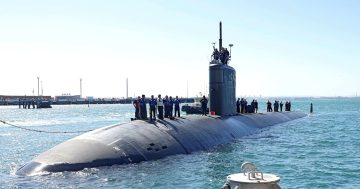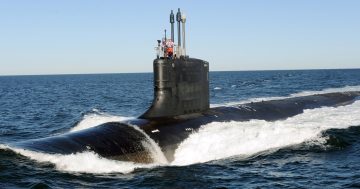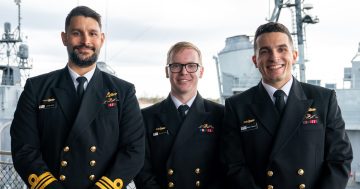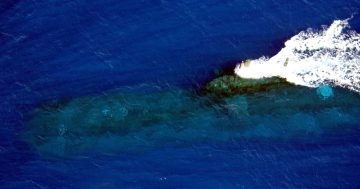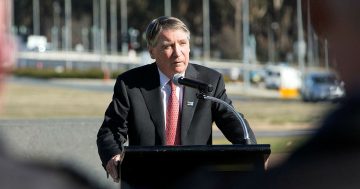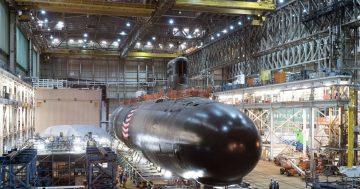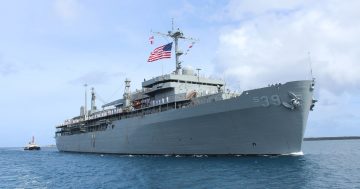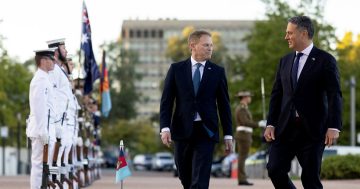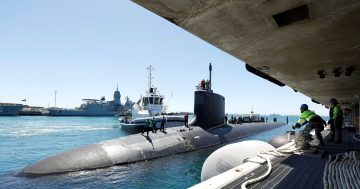
Virginia-class submarine production continues to languish below 1.2 units a year, well below the 2.3 rate required for the US Navy to provide the boats to Australia. Photo: General Dynamics Electric Boat.
A US Navy admiral has said Australia won’t receive any Virginia-class nuclear-powered submarines from the US unless the current production rate is doubled.
Admiral Daryl Caudle was testifying to the US Senate Committee on Armed Services on 24 July as part of his confirmation hearings to become the US Navy’s next Chief of Naval Operations (CNO). He said there were “no magic beans” that would help boost the current production rate of less than 1.2 boats a year to the more than 2.3 rate it needed to be.
Under the AUKUS Pillar 1 construct, Australia is set to receive between three and five second-hand Virginia-class nuclear-powered attack submarines from 2032 to replace the current conventional Collins-class boats.
As part of this deal, Australia will invest up to $5 billion in the US industrial supply chain as part of the effort to boost the production rate. But, despite two payments totalling $1.6 billion having been made, the production rate remains stagnant and shows no indication of recovery in the short-to-medium term.
The first payment of $800 million was made in February to coincide with Defence Minister Richard Marles’s visit to Washington, DC, while a second payment of a similar amount was made in mid-July. It is believed a third payment is due to be made before the end of the year.
A former submariner himself, Admiral Caudle described Royal Australian Navy (RAN) sailors as “incredible submariners”, but added that the US wouldn’t be able to transfer any Virginia-class boats to Australia without a “100 per cent improvement” in the build rate.
“Australia’s ability to conduct undersea warfare is not in question,” he said. “But, as you know, the delivery pace is not what it needs to be to make good on the Pillar 1 of the AUKUS agreement which is currently under review by our defence department.
“We do have to understand whether or not the industrial base can produce the submarines required so that we can make good on the actual pact that we made with the UK and Australia.
“That is going to require a transformational improvement; not a 10 per cent improvement, not a 20 per cent improvement but a 100 per cent improvement.”
Admiral Caudle’s testimony and reference to the review came just days before the first public confirmation by the US Department of Defense that it was conducting the review.
In a post on Twitter/X on 30 July, the Pentagon said: “Secretary Hegseth has directed the Department of Defense to undertake a review of the AUKUS initiative.
“This review will be a department-wide process, led by the Undersecretary of Defense for Policy [Elbridge Colby]. It will be an empirical and clear-eyed assessment of the initiative’s alignment with President Trump’s America First approach.
“As part of this process, the department looks forward to continuing regular engagements on this important matter with other parts of the US Government, the US Congress, our allies Australia and the United Kingdom, and other key stakeholders.
“The department looks forward to completing the review in the [northern] fall. Its purpose will be to provide the President and his senior leadership team with a fact-based, rigorous assessment of the initiative.”
Prime Minister Anthony Albanese confirmed the second payment had been made in an interview with the ABC on 23 July, saying the payments were “about increasing their industrial capacity”.
But when asked why Australia was still making these payments while Pillar 1 was under review, the Prime Minister obfuscated, saying only that “It’s a schedule that we have of a payment that we’re making”.
“We support AUKUS,” he added. “We have an agreement. It’s a treaty-level agreement with our partners that was signed … in San Diego with the United States and the United Kingdom.”


